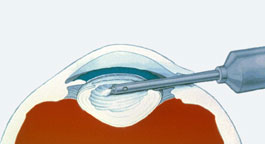What is a cataract?
A cataract is a clouding of the eye’s naturally clear lens. The lens focuses light rays on the retina at the back of the eye to produce a sharp image of what we see. When the lens becomes cloudy, the light rays cannot pass easily through it, and the image becomes blurry.

Cataracts usually develop as part of the normal aging process, but they can also result from eye injuries and certain diseases or medications. Genetic factors may also play a role in cataract development.
How is a cataract be treated?
There are no medications, eye drops, exercises or glasses that will cause cataracts to disappear once they have formed. Surgery is the only way to remove a cataract. When you are not able to see well enough to do the things you like to do, cataract surgery should be considered.
What will happen during surgery?
Surgery is usually done on an outpatient basis. When you arrive for surgery, you will be given eye drops and perhaps a sedative to help you relax. A local anesthetic will numb the eye. You may see light and movement, but you will not be able to see the surgery while it is happening. An eyelid holder is placed between your eyelids to prevent you from blinking.
 Under an operating microscope, a small incision is made in the eye. Microsurgical instruments are used to break apart and suction the cloudy lens. The back membrane of the lens (called the posterior capsule) is left in place.
Under an operating microscope, a small incision is made in the eye. Microsurgical instruments are used to break apart and suction the cloudy lens. The back membrane of the lens (called the posterior capsule) is left in place.
 The focusing power of the natural lens is restored by replacing it with an intraocular lens implant. Your eye will be measured to determine the proper power of the intraocular lens that will be placed in your eye during surgery.
The focusing power of the natural lens is restored by replacing it with an intraocular lens implant. Your eye will be measured to determine the proper power of the intraocular lens that will be placed in your eye during surgery.
 After the cloudy lens is removed, the intraocular lens is placed. Soft, foldable lenses can be inserted through a small incision which shortens recovery time following surgery. The incision is then closed.
After the cloudy lens is removed, the intraocular lens is placed. Soft, foldable lenses can be inserted through a small incision which shortens recovery time following surgery. The incision is then closed.
When the surgery is complete, the doctor will often place a shield over your eye. After a short stay in the outpatient recovery area, you will be ready to go home.
